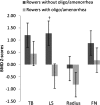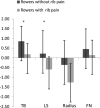Bone mineral density, rib pain and other features of the female athlete triad in elite lightweight rowers
- PMID: 24523427
- PMCID: PMC3927798
- DOI: 10.1136/bmjopen-2013-004369
Bone mineral density, rib pain and other features of the female athlete triad in elite lightweight rowers
Abstract
Objective: To determine bone mineral density (BMD) and the associations among BMD, menstrual history, disordered eating (DE), training history, intentional weight loss (IWL) and rib pain for the first time in female lightweight rowers.
Setting: 9 lightweight rowing clubs, UK.
Participants: 29 Caucasian female lightweight rowers volunteered. 21 (12 active, 9 retired) completed the study.
Inclusion criteria: female lightweight rowers aged over 18 years.
Exclusion criteria: participants with a history of bone disease, used medications known to influence BMD or if they were pregnant, lactating or postmenopausal.
Main outcome measures: Dual-energy X-ray absorptiometry measured total body (TB) composition and BMD at the spine, femoral neck (FN), radius and TB. DE, oligomenorrhoea/amenorrhoea years; rib pain and training history.
Results: DE was reported in six of the rowers. The active with DE started rowing younger (p<0.05) than those without, and their amount of IWL was associated with Eating Attitudes Test-26 score (p<0.05). Some participants reported a history of oligomenorrhoea/amenorrhoea 17 (76%) and/or rib pain 7 (32%) with those with rib pain having lower spine and TB Z-scores (p<0.05) than those without. Those with oligomenorrhoea/amenorrhoea had lower spine Z-scores (p<0.01) than those without. Twelve participants had low BMD; three at spine; one at FN; and eight at radius. Thirteen per cent of mean total training hours (18.6±9.1 h/week) were spent strength training (2.4±2.2 h/week).
Conclusions: Upper body exercises incorporating multidimensional high peak bone strain were not reported and may need to be considered in their strength training to improve radial BMD. Results suggest IWL and high-level training at a young age increases the likelihood of DE and there may be a lack of quality nutritional support for these athletes. Thus, multidisciplinary sport science support should be offered at a young age and perhaps also to consider changing the weight rules to prevent the development of the Triad.
Keywords: Sports Medicine.
Figures



References
-
- Rumball JS, Lebrun CM, De Ciacca SR, et al. Rowing injuries. Sports Med 2005;35:537–55 - PubMed
-
- Talbott SM, Shapses SA. Fasting and energy intake influence bone turnover in lightweight male rowers. Int J Sport Nutr 1998;8:377–87 - PubMed
-
- Nattiv A, Loucks AB, Manore MM, et al. American College of Sports Medicine position stand: the female athlete triad. Med Sci Sports Exerc 2007;39:1867–82 - PubMed
MeSH terms
LinkOut - more resources
Full Text Sources
Other Literature Sources
Medical
Molecular Biology Databases
Miscellaneous
